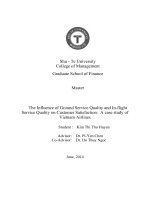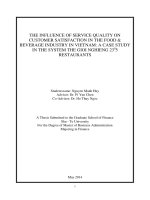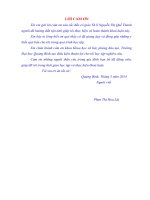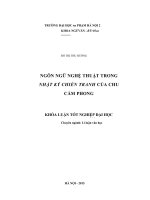Khóa luận tốt nghiệp ngoại ngữ the study on formal letters and informal letters in english
Bạn đang xem bản rút gọn của tài liệu. Xem và tải ngay bản đầy đủ của tài liệu tại đây (265.81 KB, 68 trang )
BỘ GIÁO DỤC VÀ ĐÀO TẠO
TRƯỜNG ĐẠI HỌC DÂN LẬP HẢI PHÒNG
-------------------------------
ISO 9001:2008
KHÓA LUẬN TỐT NGHIỆP
NGÀNH: NGOẠI NGỮ
Sinh viên:Hoàng Thị Ràng
Giảng viên hướng dẫn: Đặng Thị Vân, M.A.
HẢI PHÒNG - 2016
BỘ GIÁO DỤC VÀ ĐÀO TẠO
TRƯỜNG ĐẠI HỌC DÂN LẬP HẢI PHÒNG
----------------------------------
TÊN ĐỀ TÀI KHÓA LUẬN TỐT NGHIỆP
A STUDY ON FORMAL LETTERS AND INFORMAL
LETTERS IN ENGLISH
KHÓA LUẬN TỐT NGHIỆP ĐẠI HỌC HỆ CHÍNH QUY
NGÀNH: NGOẠI NGỮ
Sinh viên: Hoàng Thị Ràng
Lớp: NA 1601
Giảng viên hướng dẫn: Đặng Thị Vân, M.A.
HẢI PHÒNG - 2016
BỘ GIÁO DỤC VÀ ĐÀO TẠO
TRƯỜNG ĐẠI HỌC DÂN LẬP HẢI PHÒNG
--------------------------------------
NHIỆM VỤ ĐỀ TÀI TỐT NGHIỆP
Sinh viên: ............................................................Mã
SV:............................
Lớp: ............................
.Ngành:....................................................................
Tên đề
tài:..............................................................................................................
...................................................................................................................
...................................................................................................................
..................................................
NHIỆM VỤ ĐỀ TÀI
1. Nội dung và các yêu cầu cần giải quyết trong nhiệm vụ đềtài tốt nghiệp
( về lý luận, thực tiễn, các số liệu cần tính toán và các bản vẽ).
……………………………………………………………………………..
……………………………………………………………………………..
……………………………………………………………………………..
……………………………………………………………………………..
……………………………………………………………………………..
……………………………………………………………………………..
……………………………………………………………………………..
……………………………………………………………………………..
2. Các số liệu cần thiết để thiết kế, tính toán.
……………………………………………………………………………..
……………………………………………………………………………..
……………………………………………………………………………..
……………………………………………………………………………..
……………………………………………………………………………..
……………………………………………………………………………..
……………………………………………………………………………..
……………………………………………………………………………..
……………………………………………………………………………..
3. Địa điểm thực tập tốt nghiệp.
……………………………………………………………………………..
……………………………………………………………………………..
……………………………………………………………………………..
CÁN BỘ HƯỚNG DẪN ĐỀ TÀI TỐT NGHIỆP
Người hướng dẫn thứ nhất:
Họ và tên:.............................................................................................
Học hàm, học vị:...................................................................................
Cơ quan công tác:.................................................................................
Nội dung hướng dẫn:............................................................................
Người hướng dẫn thứ hai:
Họ và tên:.............................................................................................
Học hàm, học vị:...................................................................................
Cơ quan công tác:.................................................................................
Nội dung hướng dẫn:............................................................................
Đề tài tốt nghiệp được giao ngày 18 tháng 4 năm 2016
Yêu cầu phải hoàn thành xong trước ngày 09 tháng 7 năm 2016
Đã nhận nhiệm vụ ĐTTN Đã giao nhiệm vụ ĐTTN
Sinh viên
Người hướng dẫn
Hải Phòng, ngày ...... tháng........năm 2016
Hiệu trưởng
GS.TS.NGƯT Trần Hữu Nghị
PHẦN NHẬN XÉT CỦA CÁN BỘ HƯỚNG DẪN
1. Tinh thần thái độ của sinh viên trong quá trình làm đề tài tốt
nghiệp:
……………………………………………………………………………..
……………………………………………………………………………..
……………………………………………………………………………..
……………………………………………………………………………..
……………………………………………………………………………..
……………………………………………………………………………..
2. Đánh giá chất lượng của khóa luận (so với nội dung yêu cầu đã đề ra
trong nhiệm vụ Đ.T. T.N trên các mặt lý luận, thực tiễn, tính toán số
liệu…):
……………………………………………………………………………..
……………………………………………………………………………..
……………………………………………………………………………..
……………………………………………………………………………..
……………………………………………………………………………..
……………………………………………………………………………..
……………………………………………………………………………..
……………………………………………………………………………..
3.Cho điểm của cán bộ hướng dẫn (ghi bằng cả số và chữ):
……………………………………………………………………………..
……………………………………………………………………………..
……………………………………………………………………………..
Hải Phòng, ngày … tháng … năm 2016
Cán bộ hướng dẫn
(Ký và ghi rõ họ tên)
Acknowledgements
During the process of doing the graduation papers, I have received a lot of
advice, suggestions and helps from many people. Without their support, the
study would have been made impossible.
On this occasion, I am deeply indebted to my teacher, Ms Dang Thi Van, M.A,
the supervisor, who has been giving my study her very warm welcome by
guidance, materials and corrections during the preparation and development
of this study.
I would like to express my very sincere thanks to all teachers of Foreign
Language Department of Hai Phong Private University for their valuable
lectures during my study and graduation time.
I also wish to extend my many thanks to my family and my friends for their
day- to- day assistance and encouragement as ever before.
Hai Phong, June 2016
Hoang Thi Rang
TABLE OF CONTENTS
Acknowledgements
Table of contents
PART ONE: INTRODUCTION
1. Rationale……………………………………………….......................1
2. Aims of the study……………………………………………………..2
3. Scope of the study…………………………………………………….2
4. Methods of the study………………………………………………….2
5.Design of the study…………………………………………………....3
PART TWO: DEVELOPMENT
CHAPTER 1: LITERATURE REVIEW……………………………..4
I. Writing………………………………………………………………...4
1. Definition of writing…………………………………………….4
2. Types of writing…………………………………………………5
3. Writing process………………………………………………….6
II. Letters………………………………………………………..............7
1.Definition of letter…………………………………………….....7
2. Letter writing basics………………………………………….….8
III. Classification of letters……………………………………………...9
1. Formal letters……………………………………………………..9
1.1.
Business letters………………………………………………10
1.1.1. Complaint letters………………………………………….10
1.1.2. Inquiry letters……………………………………………..11
1.1.3. Order letters……………………………………………….11
1.1.4. Acknowledgement letters………………………………....12
1.1.5. Application letters………………………………………...12
1.2.
Social letters………………………………………………….13
1.2.1. Congratulations letters…………………………………….13
1.2.2. Condolence letters………………………………………...14
1.2.3. Apology letters……………………………………………14
1.2.4. Invitation letters…………………………………………...15
1.2.5. Thanks letters……………………………………………...15
2. Informal letters…………………………………………………….16
2.1.
Congratulations letters…………………………………….16
2.2.
Condolence letters…………………………………………17
2.3.
Apology letters…………………………………………….17
2.4.
Invitation letters…………………………………………....17
2.5.
Thanks letters…………………………………………..….18
CHAPTER 2: THE STUDY ON FORMAL LETTERS AN INFORMAL
LETTERS IN ENGLISH
I.
Formal Letters……………………………………………………19
1. Complaint letters………………………………………………..…...19
1.1 .Format of Complaint letters in Business……………………………19
1.1.1 . Opening………………………………………………………….22
1.1.2 . Body of letters…………………………………………………...23
1.1.3 . Closing…………………………………………………………...24
1.2. Content, style and language………………………………………25
2.
Congratulations letters …………………………………………....27
2.1. Types of congratulations letters……………………………………27
2.2. Content, style and language……………………………………….29
II.
Informal letters………………………………………………..…..31
1. Congratulations letters……………………………………………...31
1.1. Types of congratulations letters…………………………………..32
1.2. Content, style and language ……………………………………...33
2. Invitation letters ……………………………………………………..35
2.1 Format of invitation letter………………………………………....35
2.2 Content, style and language ……………………………………....38
CHAPTER 3: ERRORS MADE BY VIETNAMESE LEARNERS IN
WRITING FORMAL LETTERS AND INFORMAL LETTERS IN
ENGLISH.
I. Errors in content…………………………………………..….40
II. Errors in style………………………………………………....43
III. Errors in language…………………………………………….45
IV. Some suggestions to Vietnamese learners for writing English
letters…………………………………………………………46
PARTTHREE: CONCLUSION……………………………...49
REFERENCES………………………………………………………...50
APPENDIXE 1…………………………………………………………52
APPENDIXE 2…………………………………………………………53
APPENDIXE 3…………………………………………………………54
PART ONE: INTRODUCTION
1. Rationale
Writing letter plays an important role in our life and it is used in all fields,
for example, business, education, tourism, daily communication, etc.
Letter is, first of all, the means used by people to keep in touch with their
family, relatives or friends. In business, it is used by the company to
contact and exchange information with its customers.
In the stage of modernization of the country, the cooperative and
developed opportunities are available, exchanging letter has become more
and more important especially the letter written in English.
There is a fact that not all people are able to write an English letter
successfully due to the limitation of knowledge. Writing a good letter
means you use a special language in appropriate format and clear content
to persuade the receivers and make a good impression on them.
Writing a successful English letter is not really easy. It becomes a common
problem not only to students but also to employees. There are some
differences between formal and informal letter in term of format, style and
language. People sometimes make mistakes in their letters without being
aware about it.
Realizing the above issues, I decided to carry out “the study on formal
letters and informal letters in English” to help learners deeply understand
1
about these types of letter with the hope that they can write an English
letter better.
2.
Aims of the study
The aims of the study are:
- Giving literature review of definition, writing process and classification
of writing as well as classification of letters.
- Providing the basic and essential knowledge about the format, style and
language used in formal letters and informal letters.
- Finding out some common errors in writing English letter to help
learners avoid making those mistakes and have good skill in writing
letter.
3.Scope of the study.
There are many different types of formal letters and informal letters that
need to be analyzed. However, because of the limitation of time and
knowledge, I can only focus on some typical types and finding out the
most common errors made by Vietnamese learners when they write
English letter.
I hope that students and readers will find my study useful in their study
and communication in their life. I do expect and highly appreciate their
comments, suggestion to make the study better.
2
4.Methods of the study
To finish this graduation paper, I search and collect the necessary
knowledge from different reference books related to English writing and
from the websites on the internet.
This paper provides readers with many model English letters. Besides, I
carry out the qualitative method in which some typical letters are analyzed
to help learners understand clearly about the format, content, style and
language in each type as well as the possible mistakes in writing letter.
5.Design of the study
My graduation paper is divided into three parts, in which the second part is
the most important part
The first part is the introduction which presents the rationale for
choosing the topic and point out the aims of the study, the scope of the
study, methods and design of the study.
The second part is development which consists of three chapters.
Chapter 1: Literature review which provides reader with definition of key
terms including writing and letter as well as classification of letters.
Chapter 2: Focuses on some types of formal letters and informal letters.
The
format,
content,
style
and
language
of complaint
congratulations letters and invitation letters are analyzed.
3
letters,
Chapter 3: Points out the possible errors in writing letter and give some
suggestion to Vietnamese learners for improving writing English letter
skill.
The last part is the conclusion. In this part, the content of previous parts is
summarized
CHAPTER 1: LITERATURE REVIEW
4
Chapter 1 helps readers have a first look at definition of writing and writing
process. This chapter also introduces an overview of letter as well as their
classification.
I.Writing
1. Definition of writing
Writing plays an important role in our life. It is a skill that people in all parts
of life use every day. A teacher, for example, has to write lectures, a chief
accountant has to write reports to general director every month. As a student,
I have a pile of writing tasks: essays, assignments, internship report,
graduation study, etc. Therefore, a good writing skill is what I need to equip.
Here are some different definitions of writing.
"Writing" is the process of using symbols (letters of the alphabet,
punctuation and spaces) to communicate thoughts and ideas in a
readable form.
(www.englishclub.com/writing)
Another definition of Writing is “a medium of human communication
that represents language and emotion through the inscription or
recording of signs and symbols”.
(www.en.wikipedia.org/wiki/Writing)
During my study process at Hai Phong Private University, I find writing a
hard-work skill. In other words, writing is a process that everybody has to
practice regularly. In addition to good writing skill, learners should read
more to find the different ways in organizing writings, and widen knowledge.
2. Types of writing
5
According to Stephen Bailey (2006: p.3), most university and college
students are assessed through the production of written assignments.
Some of the terms used to describe different types of assignments can be
confusing. In addition, students need to be obvious about the basic
components of written texts. In other words, the types of writing can be
made clear andthe following table shows the main purpose of each and
usual approximate length
Type
Purpose
Length
Letter
For formal and informal
Usually fewer
communication
than 500
words
Note
To record reading or
Depends on
lectures
each reading
or lecture
Report
To describe something a
1,000-2,000
student has conducted, e.g.
an experiment/a survey
Project
Research conducted either
1,000-3,000
individually or in group on
subject chosen by student(s)
Essay
Piece of writing used to
1,000-5,000
assess coursework/subject
chosen by teacher
Thesis/dissertation
Long piece of writing on
subject chosen by student
for final assessment in
Master’s/PhD course
6
30,000-70,000
Article/paper
Writing published in
5,000-10,000
academic journal
(Bailey, 2006: p3)
3. Writing Process
As we know, writing is known as a method of communication. Good
writing skills allow us to communicate our message clearly and
obviously and also help learner write fluently.
Based on The Oxford Essential Guide To Writing, the author pointed out
writing in its broad sense as distinct from simply putting words on paper
has three steps: Thinking about it, doing it, and doing it again and again
and again, as often as time will allow and patience will endure).(Thomas
S. Kane, p.17)
*The first step, “thinking”, or is called “prewriting” includes:
Prewriting is the process of coming up with ideas for your essay
There are some prewriting techniques that we can discuss:
-Analyzing the assignment: You have to sure that you understand the
assignment. You should take some questions what, where, when, why,
how…
- Brainstorming: You should quickly generate ideas (examples, reasons,
personal experiences and otherdetails) in the form of notes, a list, a
diagram, a mind map, or columns.
- Outlining: You may find that different ideas in brainstorming can be
written in different paragraphs. So you need to organize your ideas by
making an outline and add relevant ideas.
*The second step, “doing,” is usually called “drafting”.
The author considered “a draft” is an early version of a piece of writing.
Most of us cannot compose anything well at the first try. We must write
and rewrite. As a rule, the more you draft, the better the result. You
7
create the complete sentences from the ideas in your outline and write
the sentences in paragraph.
In the draft, mistakes can be made and your writing structure doesnot
need to be perfect.
*The third step, “doing it again”.
After draft writing, we rework the writing so that the ideas are expressed
in the best way possible.
At last we check the organization of your paragraph and ideas every
misspelling in a dictionary, using verbs, pronouns, and modifiers
correctly.
Writing process is very important. It goes through many stages such as
understanding, collecting information, and writing. If you deeply
understand about writing process and frequently practice writing
following these above steps. You will improve your overall ability to
communicate in English and you will be a good writer.
II. Letters
1. Definition of letter
In many years, writing letter is one of the ways to show your deep
emotion and very meaningful. People still send the sincere letters to each
other on special occasion or celebration even on any day that they like.
So, what is a letter?
“Letter is a written or printed communication directed to a person or
organization.”
( />Letter is also defined a written message from one person to another,
usually put in an envelope and sent by post
( />Letters can be created and sent as:
E-mail or electronic transmissions
8
Hand-delivered transmissions
Regular mail transmissions
2. Letter writing basics
According to Robert W.Bly (2004: p. 3), the letter writing basics include:
-
Prewriting Planning
In this part, we should focus on some simple steps for planning a letter or
other communication of any significance:
• Do a SAP(subject, audience, and purpose) analysis as outlined in the
sections that follow. The process requires you to ask and answer three
questions:
What is the subject (topic) of your letter?
Who is your audience? (Who will be receiving your letter?)
What is the purpose of your letter?
• Gather the information you need and do whatever additional research is
required to complete the letter.
• Make a simple 1-2-3 outline of the points you need to cover, in the
order you want to present them
-
Twelve Rules for better letters writing
Present your best self
Write in a clear, conversational type
Be concise
Be consistent
Use Jargon sparingly
Avoid big words
Prefer the specific to the general
Break up your writing into short sections
Use visuals
Use the active voice
Organization
9
Length.
-
Tone
There are four basic options for letter tone – forceful, passive, personal, and
impersonal
• Forceful Tone
Forceful tone is used when addressing subordinates or other who,basically,
have to do what you tell them to do. You are not asking them, you are
ordering them in no uncertain terms.
• Passive Tone
Passive tone is used when addressing superiors and others who, basically,
you have to listen to and please – bosses, customers, clients.
• Personal Tone
Personal tone is used when you want to give support or establish or
improve a relationship. It is most appropriately used with people you know,
rather than strangers, or at least with people whose situations you know
about and empathize with.
• Impersonal Tone
Impersonal tone is used when you either want to keep a relationship on a
strictly professional level, or when you want to distance yourself from the
other person or the subject at hand.
II. Classification of letters
1. Formal letters
Formal letter is written in the formal language with a specific format. In
simple terms, this is a letter written for professional communication.
Formal letters are divided into two main types: Business letters and social
letters
1.1. Business letters
Business letters are used to exchange thoughts and ideas in connection
with a monetary dealing of man and organization.
10
1.1.1. Complaint letters
A complaint letter is written to show one that an error has occurred and
need to be corrected as soon as possible. It can be used for warning the
reader.
Dear Mr Haynes,
I am writing to complain about your two dogs.
Although I have repeatedly asked you to prevent the dogs from
leaving your garden, you have failed to do so. As a result, my front
garden has been dug up twice over the past three days.
Furthermore, their barking is extremely annoying, both to local
residents and myself.
Finally, I feel that these dogs have a tendency to be aggressive, as I
have told you in the past. Nevertheless, they are allowed to roam
the streets of our neighborhood, which I consider unacceptable.
I hope that this matter can be resolved.
Your sincerely
William Penton
(Malkoc, 1988, p19)
1.1.2. Inquiry letters
An enquiry letter is written to seek information from other
organizations. It may be deal with a simple matter.
Tipton Travel,
Inc.Sept.15,1988
Fifth Avenue
Greenburg, VT 11111
11
Attention: World Travel Reservations
Please reserve on seat on your Around-the Word tour leaving
Greenburg on March 30, returning May 30. I am enclosing a down
payment of S500.00 (five hundred dollars) by personal check.
Please bill me for the remainder.
Alice Adam Harris
Mrs. J. H. Harris
Mrs. J. H Harris
Rockford Arms Hotel
Rockford, CO 33333
(Malkoc, 1988, p23)
1.1.3. Order letters
This letter is used for ordering the products or services.
Blackstone Book Agency
September 15, 1988
Sixth and Riverside Avenue
Olympia, WA 99999
Attention: Ms. R. Smith
Dear Ms. Smith:
Would you please send me a copy of Word Wide Dictionary,
unabridged second edition, 1982.I am enclosing a money order for
37.50 to cover cost and handling.
If this amount is not correct, please let me know.
Thanking you in advance,
Yours truly
Josephine Black Principal
Dr. Josephine Black,Principal
12
City College
Mountainview, WA 99999
(Malkoc, 1988, p22)
1.1.4.
Acknowledgement letters
This type ofletter is written to acknowledge someone for his/her help
or support. It can be used to say thanks for something you have
received from someone.
9/15/88ABC
Corporation
123 Long street
Bigtown, CA 88888
Dear Director:
This is to acknowledge receipt of the housing contract that I
requested.
Thank you for your promotness.
Yours truly
Thomas R Hood
Thomas R. Hood Associates
Fourth and Pine Streets
Los Angeles, CA 88888
(Malkoc, 1988, p16)
1.1.5.
Application letters
Sept. 15, 1988
Registrar’s Office
State University
13
Littleton, SD 55555
Dear Registrar:
I am a student of microbiology in Geneva, Switzerland. I would like
to apply for entrance to your university. Would you please send me
an application form and information on your university.
Thank you
Yours truly
Renee Martin
BlancApt. 406
Geneva, Switzerland
(Malkoc, 1988, p17)
Depending on different purposes, application letters are created
different such as Leave application letters, loan application letters or
job application letters
1.2 Social letters
1.2.1. Congratulations letters
A Congratulations letter is used to acknowledge the good news sends
wishes and blessings for the receipient.
West 12 Main Street
Howard, CA 8888
September 15,1988
Dear Mr. and Mrs. Miller,
Congratulations on the birth of your daughter Melissa. May you
enjoy all the blessings of parenthood.
With very best wishes,
Sincerely,
David R. Johnson
14
David R Johnson
(Malkoc, 1988, p10)
1.2.2.Condolence letters
Condolence letter is a letter in which writer shows his/her sympathy for
receipient because one of their friends or relatives has passed away.
211 Oak Aidge Park
Youngtown, OH 33333
September 15,1988
Dear Ms. Rogers,
We were sorry to hear aboutyour illness andhope that you recover
soon.
With best wishes for a speedy recovery,
Your English class,
(by) Henry Moore
( by Henry Moore)
(Malkoc, 1988, p8)
1.2.3. Apology letters
An apology letter is a way of expressing regret towards a past action
555 Rosamond Street
Greenville, MA 22222
September 15, 1988
Dear Mr. Smith,
I want to apologize for not having answered your very kind letter
sooner, but I have been away on a trip and just returned today.
The photographs you sent are beautiful. My family and I appreciate
them very much. They are the best kind of remembrance, and we are
very grateful.
15









